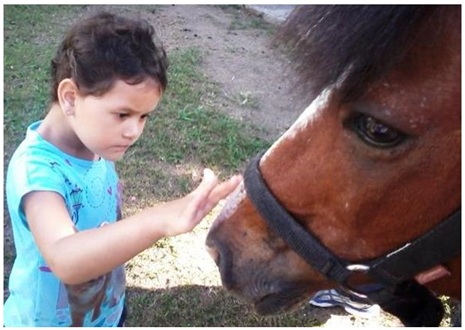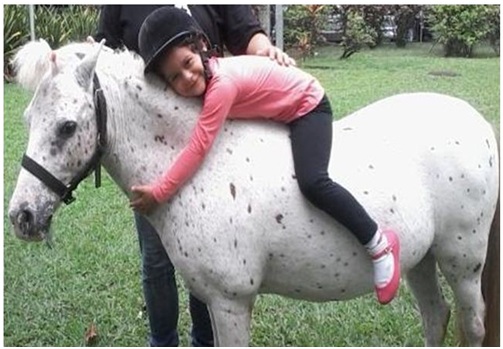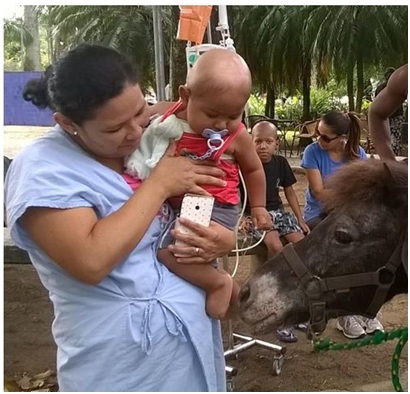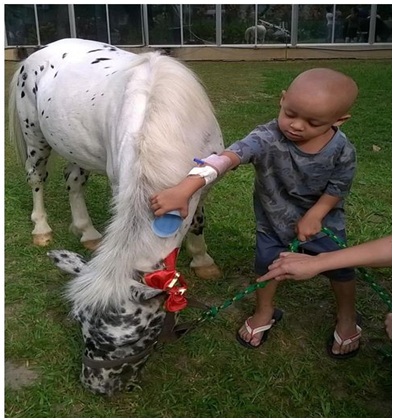
Journal of Animal Research & Veterinary Science Category: Agriculture
Type: Research Article
An Experience with Zootherapy - Animal Assisted Therapy with Ponies
*Corresponding Author(s):
Ana Stela FonsecaSpecialist In Traditional Chinese Medicine, Riding Instructor, WATCVM Board Member, IVCA Member, Gainesville, United States
Tel:+55 21983754007,
Email:naturalanimalmovement@gmail.com
Received Date: Jun 05, 2019
Accepted Date: Jul 17, 2019
Published Date: Jul 24, 2019
Abstract
Human and horses had an important relationship around centuries in all the world. Since the domestication horses are used to carry the humans being and to work with and used for wars. After the centuries some sports used horses for their practice narrowing the relation between horses and humans. Nowadays horses are a very important element in our society being our pets in home farms or like important therapeutics in big cities. The new aspect of this integration between horses and humans are seeing in this related experience in a public hospital with children with cancer in Rio de Janeiro, Brazil.
Keywords
AAT; Animals benefit; Horse-Human relationship; Well-being; Zootherapy
INTRODUCTION
The use of horses by humans has been a historical means of settle and civilization and the equestrian sports of today have kept this tradition through their rituals and procedures. Brazil is one of the countries that have equestrian tradition this started at 17th century when the Dutch occupied the Brazilian Northeast. Horsemanship as an organized sport has become more evident in the military institutions in Rio de Janeiro since 1810 [1]. The Greek used to ridden horses with people with chronic and incurable diseases. They believed that horses could heal people [2]. The horse’s sensitivity to emotions could make it suitable for use in working with specific groups of clients [3].
The relationship between humans and horses come from the early time. In the book Walking the Way of the Horse, Hallberg say that horses are evolving and changing-in partnership with humans and the needs of the time. She says that horses are magnificent creatures that offer a unique window in our souls and if we hope to develop the kind of integrity that leads to meaningful and lasting change with our horses then whatever we hope to do for the horse we must first create within ourselves. In other words, “healer, heal thyself” [4-6].
In a work made in Cadiz University-Spain shows that Animal Assisted Therapy can improve body conditions in relax the pression, make better the cardiovascular system, motor function e enhance the physical and mental health. The psychological and mental aspects and self-estimated have an improvement otherwise a diminished of stress, anxiety and solitudes make a better relaxing of the all patient. In the social aspects, the patients show a better relation with the others, sociability and health care. There is an improvement in verbal communication, memory capacity, concentration, responsibility and their own perception about the size, tall and form. Although promotes a better experience when work in a group, an interaction with others, at receptivity, desire to make sports, the sense of utility and the capacity to control the expression of feelings. Promote entertainment with a good distraction that animals make to the people [2].
The relationship between humans and horses come from the early time. In the book Walking the Way of the Horse, Hallberg say that horses are evolving and changing-in partnership with humans and the needs of the time. She says that horses are magnificent creatures that offer a unique window in our souls and if we hope to develop the kind of integrity that leads to meaningful and lasting change with our horses then whatever we hope to do for the horse we must first create within ourselves. In other words, “healer, heal thyself” [4-6].
In a work made in Cadiz University-Spain shows that Animal Assisted Therapy can improve body conditions in relax the pression, make better the cardiovascular system, motor function e enhance the physical and mental health. The psychological and mental aspects and self-estimated have an improvement otherwise a diminished of stress, anxiety and solitudes make a better relaxing of the all patient. In the social aspects, the patients show a better relation with the others, sociability and health care. There is an improvement in verbal communication, memory capacity, concentration, responsibility and their own perception about the size, tall and form. Although promotes a better experience when work in a group, an interaction with others, at receptivity, desire to make sports, the sense of utility and the capacity to control the expression of feelings. Promote entertainment with a good distraction that animals make to the people [2].
JUSTIFICATIVE
Since the early 1990’s the field of Equine Facilitated Mental Health/Education Services has experienced explosive growth. In US, there are three internationally recognized associations with memberships ranging into the thousands, which are design specifically to provide support to both practitioners and clients. Approximately 80 therapeutic boarding schools (governed by the National Association of Therapeutic Schools and Programs-NATSAP) utilize Equine Facilitated/Assisted programming [7-9].
In Brazil, the only therapy with animals that is recognized is hypnotherapy that provides support for the person with Down syndrome, Autism and Cerebral Palsy. Animal Assisted Therapy or other type of therapy with animals is still growing up with no Federal regulations or local associations. Many Equine Assisted Therapy papers talk about the relevance of the therapy in emotional regulation, which may play a significant role in the maintenance of several psychological problems including eating, self-harms suicide and low self-esteem [3].
In Animals Classification: Animals have been differentiated and classified based on their work tasks and service use, with six functional categories of animals identified: Service animals; public service animals; therapy animals; visitation animals; sporting, recreational, or agricultural animals; and support. In the nomenclature of Parenti et al., service animals are trained to perform tasks related to an individual’s disability, such as a seeing-eye dog or seizure-alert dog. Public service animals are trained to assist public service professionals in their jobs, such as search-and-rescue dogs or police dogs. Therapy animals assist a healthcare professional in a therapeutic treatment. Physical therapists, occupational therapists, nurses, and other professionals may integrate therapy animals into their practice. Visitation animals are trained to provide comfort through interactions and can be found in nursing homes or schools. Sporting, recreational, or agricultural animals are trained in skills for competition, farm work, or socioemotional benefits of AAT for recreation. Examples of these types of animals include hunting dogs and agility dogs. Support animals provide physical or mental support to those in need in their homes; they are known as social therapy dogs or home-help dogs.
This paper have the objective to show how much important and useful can be the utilization of horses-ponies for help in the treatment of child with cancer and others chronic disease. In our situation, questions as logistic and pony transportation are very much minimize just for the position of the two entities be in front of each other. In this project, we use ponies from Brazilian Pony Club located in Brazilian Hipic Society in Rio de Janeiro, which is located beside the public hospital, Federal Lagoon Hospital where there is a huge an important garden of Burle Marx.
In Brazil, the only therapy with animals that is recognized is hypnotherapy that provides support for the person with Down syndrome, Autism and Cerebral Palsy. Animal Assisted Therapy or other type of therapy with animals is still growing up with no Federal regulations or local associations. Many Equine Assisted Therapy papers talk about the relevance of the therapy in emotional regulation, which may play a significant role in the maintenance of several psychological problems including eating, self-harms suicide and low self-esteem [3].
In Animals Classification: Animals have been differentiated and classified based on their work tasks and service use, with six functional categories of animals identified: Service animals; public service animals; therapy animals; visitation animals; sporting, recreational, or agricultural animals; and support. In the nomenclature of Parenti et al., service animals are trained to perform tasks related to an individual’s disability, such as a seeing-eye dog or seizure-alert dog. Public service animals are trained to assist public service professionals in their jobs, such as search-and-rescue dogs or police dogs. Therapy animals assist a healthcare professional in a therapeutic treatment. Physical therapists, occupational therapists, nurses, and other professionals may integrate therapy animals into their practice. Visitation animals are trained to provide comfort through interactions and can be found in nursing homes or schools. Sporting, recreational, or agricultural animals are trained in skills for competition, farm work, or socioemotional benefits of AAT for recreation. Examples of these types of animals include hunting dogs and agility dogs. Support animals provide physical or mental support to those in need in their homes; they are known as social therapy dogs or home-help dogs.
This paper have the objective to show how much important and useful can be the utilization of horses-ponies for help in the treatment of child with cancer and others chronic disease. In our situation, questions as logistic and pony transportation are very much minimize just for the position of the two entities be in front of each other. In this project, we use ponies from Brazilian Pony Club located in Brazilian Hipic Society in Rio de Janeiro, which is located beside the public hospital, Federal Lagoon Hospital where there is a huge an important garden of Burle Marx.
MATERIAL AND METHODS
The use of Animal Assisted Therapy in the garden of a Public Hospital in Rio de Janeiro were started five years ago with the idea to use ponies to help to improve the happiness and health of the child submitted to treatment with cancer. The hospital is neighborhood of the Sociedade Hipica Brasileira (SHB), one of the most traditional riding clubs in Brazil. The Hospital has a beautiful and important garden made by a famous Brazilian garden stylist Burle Marx. The Pony Club of Brazil is a school of riding horse located into the SHB was children between 2-10 years old started to ride horses with small ponies that have no more than one meter of taller. The little ponies made that children started they rider`s life with more trust, safety and possibility to have more enhance in malleability and dominium on the horses. Weekly two ponies from the Pony Club of Brazil ‘literally cross the street’ to go to the garden of Lagoon Public Hospital be the therapist of the children that are in the hospital just for a doctor appointment or for a cancer treatment. Other types of chronic diseases that are been treated at the hospital as Down syndrome, Autism, Cerebral Palsy, Hyperactivity and others used to participate from the treatment. The treatment consist in an approaching of the children with the pony that start in touch, brush the hair, hug, ride and sometimes in help to halter the pony when another children is riding. The children ridden the ponies using helmet for their safety and holder for one voluntary person trained for that. In our therapy the child seat directly to the pony skin. The reason why we do not use saddles or other type of interaction between the children body and pony body is why the directly contact between the two bodies stimulate the energy flow directly from the horses-ponies body to the child body. In Traditional Chinese Medicine as Traditional Chinese Veterinary Medicine, the horse (pony) is the most Yang animal at the nature, and the Yang is the energy responsible for the Immunological System. The most powerful Yang meridian in the body of horses, ponies or any animals including humans is in the back. Since the Immunological system is directly related to the cancer when we do this “attachment” we improve the Yang energy and the immunological system in the child. In cases of Down or Cerebral Palsy sometimes is needed two voluntaries to holder one each side of the child. At the first moment some children are afraid in this case the use of the brush stimulated the approach and make that the children feel the animal more close without fear. This interaction made children feel happiest, confident and self-estimated. In a study, Catharina Carlsson and her team, reinforce the theory that Equine-Assisted Psychotherapy facilitates the restoration of trust and building relationships between staff members and their clients. It also seems to developed communication skills, emotional awareness, and regulation, as well as reducing anxiety [3].
In the picture below is possible to see the facial expression of one child in her first contact with a pony in Zootherapy. Her expression is tense, thigh, closed she had been treated for cancer and was at control time (Figures 1-4).
In the picture below is possible to see the facial expression of one child in her first contact with a pony in Zootherapy. Her expression is tense, thigh, closed she had been treated for cancer and was at control time (Figures 1-4).
 Figure 1: The girl looks tense, tight, expressing fear in touching the pony.
Figure 1: The girl looks tense, tight, expressing fear in touching the pony. Figure 2: In the second picture the same child at control time some months after can show relax and happiness when ridding and hugging the little pony.
Figure 2: In the second picture the same child at control time some months after can show relax and happiness when ridding and hugging the little pony. Figure 3: Other important moment is when some children can go to the garden; see the ponies when doing chemotherapy.
Figure 3: Other important moment is when some children can go to the garden; see the ponies when doing chemotherapy.
Figure 4: Brushing and touching the little pony make the children relaxed, happier and forget that they are in a hospital submitted to a cancer treatment.
CONCLUSION
In BRUZEK experience he said that while their service to humans has been long acknowledge and valued, the amount of empirical research on their roles in improving psychological and emotional well-being is relatively limited. Finally, despite reported positive effects, many studies were limit by methodological weaknesses. The analyses undertaken in this review emphasize the need for further, more rigorous research to validate the effectiveness of animal-assisted therapy for mental health outcomes. Directions for future research are discussed [10,11]. In our experience at five years of practicing Zootheraphy at Hospital da Lagoa is possible to see that the facial expression, happiness, talk more and all the expressing with smiles, talking, laughing from the children demonstrate that Zootherapy or Animal Assisted Therapy with ponies in a hospital can enhance the happiness, the encouraging, make children forget their pain, sickness for a while and should be an important role in Complementary Therapy specially for children with Cancer. This therapy can help others in chronic diseases to enhance the quality of life, the well-being and the self-estimate, been necessary more studies in the future for prove all the benefits.
REFERENCES
- Pereira da costa L (2005) Atlas do Esporte no Brasil, Shape Editora e Promoções Ltda, Rio de Janeiro, Brazil.
- Zooterapia (2017) Universidad de Cádiz, Espanha. Pg No: 10-14.
- Carlsson C, Ranta DN, Traeen B (2014) Equine assisted social work as a mean for authentic relations between clients and staff. Human Animal Interaction Bulletin 2: 19-38.
- Hallberg L (2008) Walking the Way of the Horse, Universe Inc, New York Bloomington, USA.
- Digard JP (1998) Les Français et leurs animaux, Comptes Rendus, Fayard, Paris, Pg No: 161-164.
- Anderson MK, Friend TH, Evans JW, Bushong DM (1999) Behavioural assessment of horses in therapeutic programs. Appl Anim Behav Sci 63: 11-24.
- Hausberger M, Roche H, Henry S, Visser EK (2008) A review of the human–horse relationship. Applied Animal Behaviour Science 109: 1-24.
- Smith AV, Proops L, Grounds K, Wathan J, McComb K (2016) Functionally relevant responses to human facial expressions of emotion in the domestic horse (Equus caballus), Biol Lett 12.
- Hamilton AJ (2011) Zen Mind, Zhen Horse: The Science and Spirituality of Working with Horses. Stoney Publishing. California, USA.
- Bruzek CE (2014) Socioemotional Benefits of Animal-Assisted Occupational Therapy with Children: A Review of the Literature and Directions for Future Research. University of South Florida St. Petersburg, Florida, USA.
- Corthay A (2014) Does the Immune System Naturally Protect Against Cancer? Front Immunol 5: 197.
Citation: Fonseca AS (2019) An Experience with Zootherapy - Animal Assisted Therapy with Ponies. J Anim Res Vet Sci 3: 018.
Copyright: © 2019 Ana Stela Fonseca, et al. This is an open-access article distributed under the terms of the Creative Commons Attribution License, which permits unrestricted use, distribution, and reproduction in any medium, provided the original author and source are credited.

Journal Highlights
© 2024, Copyrights Herald Scholarly Open Access. All Rights Reserved!
